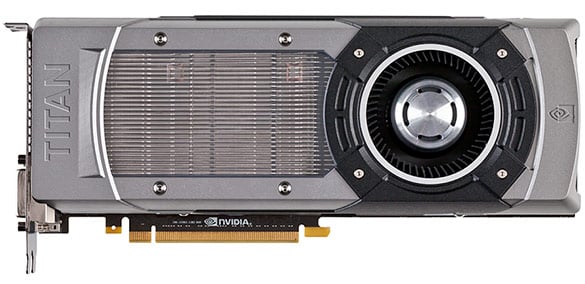NVIDIA GeForce GTX Titan Powered Maingear SHIFT
Introduction and Specifications
NVIDIA is launching a new, ultra high-end graphics card today, the long rumored GeForce GTX Titan. Although the card itself and a couple of its features are new to the consumer graphics card market, many details of the GPU powering the GTX Titan, namely the NVIDIA GK110, have been previously covered here at HotHardware. In fact, NVIDIA revealed the GK110 at GTC 2012 in May of last year and released its first Tesla-branded products based on the GPU a few months later. The GK110 is also a key component of the GeForce GTX Titan’s namesake, the Titan Supercomputer, which uses almost 19,000 of the GPUs in tandem to crunch numbers at a brisk 20 petaflops. Products designed for the HPC space are somewhat different than what power our gaming PCs though. The GPUs on the cards may be similar, but the power, form factor and budget considerations are in totally different leagues.
Those requirements compelled NVIDIA to design the GeForce GTX Titan in such a way that it will not only usher in a new class uber-powerful gaming systems that can rip through today’s hottest games without breaking a sweat, but high-end small form factor systems as well. We’ve got the GeForce GTX Titan’s main features and specifications detailed below, along with some related reading materials if you’d like a refresher on some of the technologies at work inside GK110 GPU. Many more details follow on the pages ahead, though you’ll have to wait a little while longer, as we're held on embargo with the results of our benchmarks and performance tests. (Update: GeForce GTX Titan performance available here.)

The GK110-Based NVIDIA GeForce GTX Titan
|
| Graphics Processing Clusters | 5 |
| Streaming Multiprocessors | 14 |
| CUDA Cores (single precision) | 2688 |
| CUDA Cores (double precision) | 896 |
| Texture Units | 224 |
| ROP Units | 48 |
| Base Clock | 836 MHz |
| Boost Clock | 876 MHz |
| Memory Clock (Data rate) | 6008 MHz |
| L2 Cache Size | 1536K |
| Total Video Memory | 6144MB GDDR5 |
| Memory Interface | 384-bit |
| Total Memory Bandwidth | 288.4 GB/s |
| Texture Filtering Rate (Bilinear) | 187.5 GigaTexels/sec |
| Fabrication Process | 28 nm |
| Transistor Count | 7.1 Billion |
| Connectors |
2 x Dual-Link DVI |
| Form Factor | Dual Slot |
| Power Connectors | One 8-pin and one 6-pin |
| Recommended Power Supply | 600 Watts |
| Thermal Design Power (TDP) | 250 Watts |
| Thermal Threshold | 95°C |
The NVIDIA GeForce GTX Titan’s main features and specifications are listed in the table above. Before we get into the specifics of the card, its GPU, and the systems it will power, however, we want to direct your attention to a few past HotHardware articles that lay the foundation for what we’ll be showing you here today.
Although the GeForce GTX Titan is built around a different GPU than its predecessors, the Kepler-based GK110 at the heart of Titan leverages technologies first introduced on previous-generation NVIDIA products. As such, we’d recommend checking out these articles for more detailed coverage of many of NVIDIA’s existing technologies that carry over to the new GeForce GTX Titan:
- GeForce GTX 690 Review: Dual NVIDIA GK104 GPUs
- NVIDIA GeForce GTX 680 Review: Kepler Debuts
- NVIDIA TXAA Brings Movie CGI Rendering To PC Games
- GPU Tech: NVIDIA Talks Fermi, Unveils Nexus
- NVIDIA GF100 Architecture and Feature Preview
- NVIDIA GeForce GTX 480: GF100 Has Landed
- NVIDIA 3D Vision Surround is Here
- NVIDIA GeForce GTX 580: A New Flagship Emerges
- NVIDIA 3D Vision 2 and The Asus VG278H LCD Review
In our Fermi and GF100 architecture previews we discuss Fermi’s architecture and its CUDA cores, Polymorph and Raster engines, among many other features. In our GeForce GTX 480 coverage, we dig a little deeper into Fermi, and discuss the first graphics card based on the technology. Our GeForce GTX 580 coverage details the GF110, the more-refined re-spin of the GF100 GPU. And in our 3D Vision Surround, 3D Vision 2, and TXAA related articles, we cover NVIDIA’s multi-monitor, stereoscopic 3D technologies, and anti-aliasing technologies, which are both an integral part of the GeForce GTX Titan. Finally, in our GeForce GTX 680 and GTX 690 articles, we discuss the Kepler GPU architecture and its features in detail.
Let's take a look at the massive GK110 GPU before we dive more deeply into NVIDIA's new Titan graphics card.







